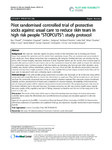Pilot randomised controlled trial of protective socks against usual care to reduce skin tears in high risk people “STOPCUTS”: study protocol
| dc.contributor.author | Powell, RJ | |
| dc.contributor.author | Hayward, CJ | |
| dc.contributor.author | Snelgrove, CL | |
| dc.contributor.author | Polverino, K | |
| dc.contributor.author | Park, L | |
| dc.contributor.author | Chauhan, R | |
| dc.contributor.author | Evans, PH | |
| dc.contributor.author | Byford, R | |
| dc.contributor.author | Charman, C | |
| dc.contributor.author | Foy, CJW | |
| dc.contributor.author | Kingsley, A | |
| dc.date.accessioned | 2015-10-14T16:48:12Z | |
| dc.date.available | 2015-10-14T16:48:12Z | |
| dc.date.issued | 2015-12 | |
| dc.identifier.issn | 2055-5784 | |
| dc.identifier.issn | 2055-5784 | |
| dc.identifier.other | 12 | |
| dc.identifier.uri | http://hdl.handle.net/10026.1/3635 | |
| dc.description.abstract |
BACKGROUND: Skin tears are traumatic injuries occurring mostly on the extremities due to shearing and friction forces that separate the epidermis and the dermis from underlying tissues. They are common and occur mostly in older adults and those taking medications that compromise skin integrity. Pretibial skin tears can develop into leg ulcers, which require lengthy, expensive treatment to heal. Traumatic injuries are the second most common type of wounds after pressure ulcers in care homes and are the commonest reason for older adults to require the attention of a community nurse. Common causes of skin tear injuries are bumping into furniture and other obstacles, using mobility aids, transfer to/from wheelchairs, getting in and out of bed and falls. No effective preventative measures currently exist but knee-length, protective socks are now available that contain impact-resistant Kevlar fibres (of the type used in stab-proof vests) and cushioning layers underneath. METHODS/DESIGN: In this pilot parallel group, randomised controlled trial, 90 people at risk of skin-tear injury will be randomised with equal allocation to receive the intervention or usual care. They will be recruited from care homes and from the community via general practices and a research volunteer database. Pilot outcomes include recruitment, eligibility, attrition, ascertainment of injuries and completion of outcome measures. Acceptability of the intervention and of study participation will be explored using semi-structured interviews. The proposed primary outcome for the future definitive trial is skin tear-free days. Secondary outcomes are skin tear severity, health status, specific skin-tears quality of life, capability and fear of falling, measured at baseline and the end of the study and in the event of a skin tear. DISCUSSION: The results of this study will be used to inform the development and design of a future randomised controlled trial to assess the effectiveness and cost-effectiveness of a unique and innovative approach to skin tear prevention. Approval was granted by the NRES - Cornwall and Plymouth Research Ethics Committee (13/SW/013). Dissemination will include publication of quantitative and qualitative findings, and experience of public involvement in peer-reviewed journals. TRIAL REGISTRATION: Current Controlled Trials: ISRCTN96565376. | |
| dc.format.extent | 12- | |
| dc.format.medium | Electronic-eCollection | |
| dc.language | en | |
| dc.language.iso | eng | |
| dc.publisher | Springer Science and Business Media LLC | |
| dc.subject | Dermatuff | |
| dc.subject | Pre-tibial lacerations | |
| dc.subject | Prevention | |
| dc.subject | Protective socks | |
| dc.subject | Skin tears | |
| dc.title | Pilot randomised controlled trial of protective socks against usual care to reduce skin tears in high risk people “STOPCUTS”: study protocol | |
| dc.type | journal-article | |
| dc.type | Journal Article | |
| plymouth.author-url | https://www.ncbi.nlm.nih.gov/pubmed/27965791 | |
| plymouth.issue | 1 | |
| plymouth.volume | 1 | |
| plymouth.publication-status | Published | |
| plymouth.journal | Pilot and Feasibility Studies | |
| dc.identifier.doi | 10.1186/s40814-015-0005-3 | |
| plymouth.organisational-group | /Plymouth | |
| plymouth.organisational-group | /Plymouth/Faculty of Health | |
| plymouth.organisational-group | /Plymouth/Research Groups | |
| plymouth.organisational-group | /Plymouth/Research Groups/Institute of Translational and Stratified Medicine (ITSMED) | |
| plymouth.organisational-group | /Plymouth/Research Groups/Institute of Translational and Stratified Medicine (ITSMED)/CCT&PS | |
| plymouth.organisational-group | /Plymouth/Research Groups/Plymouth Institute of Health and Care Research (PIHR) | |
| plymouth.organisational-group | /Plymouth/Users by role | |
| dc.publisher.place | England | |
| dcterms.dateAccepted | 2015-02-26 | |
| dc.identifier.eissn | 2055-5784 | |
| dc.rights.embargoperiod | Not known | |
| rioxxterms.versionofrecord | 10.1186/s40814-015-0005-3 | |
| rioxxterms.licenseref.uri | http://www.rioxx.net/licenses/all-rights-reserved | |
| rioxxterms.licenseref.startdate | 2015 | |
| rioxxterms.type | Journal Article/Review |


